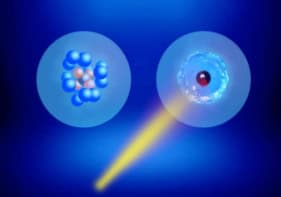
Physicists in the US have cooled a microscopic aluminium drum closer to absolute zero than previously thought possible. The researchers, working at the National Institute of Standards and Technology (NIST) in Boulder, Colorado, say that the cooling technique could be used in a range of applications including quantum computers or high-precision sensors.
The drum, which is 20 μm in diameter and 100 nm thick, was embedded on a chip as part of a superconducting circuit, explains John Teufel of NIST. To cool the drum, the researchers first placed the circuit into a vacuum chamber at 37 mK. They then circulated microwaves through the circuit. The microwave photons struck the drum’s atoms and robbed the atoms of some of their momentum. Thus, by slowing the atoms’ thermal motion, the photons lower the drum’s temperature to 360 μK.
Teufel points out that in this experiment, temperature is defined differently than conventionally understood in thermodynamics. When they say they have achieved 360 μK, this does not mean that the atoms are nearly stationary. Rather, the drum is capable of simultaneously vibrating at a range of frequencies, but in their experiment they have restricted it to only the lowest frequency.
Random kicks
For years, physicists have used photons to cool physical systems including atoms, molecules and even mirrors in optical cavities. But the photons’ cooling ability was always limited by noise, due to Heisenberg’s uncertainty principle. Teufel explains that overall, while the photons steal momentum from the drum, occasionally they give “random kicks” of momentum back to the drum because of quantum fluctuations. It had been thought that this noise would be present whenever photons were used for cooling, and it would prevent the photons from cooling beyond a specific temperature called the “quantum limit.”
His group’s innovation, Teufel explains, was to figure out how to get rid of the noise to surpass the quantum limit. The researchers achieved this by using a special type of light known as squeezed light.
Squeezed light is light with engineered uncertainty. All photons are subject to the uncertainty principle. For example, the better you know the photon’s position, the worse you know its momentum. While physicists can never get rid of this fundamental uncertainty, they have figured out that they can redistribute it. For example, if they want to know the photon’s position more precisely, they can sacrifice the precision in the momentum measurement.
Cleverly using the rules
Teufel’s group redistributed the uncertainty between a photon’s intensity and its phase, such that photons hit the drum in a co-ordinated way to eliminate random noise. He is careful to point out that they have not broken the rules of quantum mechanics. “We’re just cleverly using the rules,” he says. This technique can theoretically cool an object “arbitrarily close” to absolute zero, meaning that while reaching absolute zero is impossible, experimentalists can inch towards it, unconstrained by photon quantum noise.
This level of cooling means that they can observe vibrations in the drum due to quantum effects, which are usually drowned out by thermal motion. Furthermore, Teufel says that the cooling technique can be used to make ultrasensitive detectors such as force sensors or magnetometers. “You can very sensitively measure anything that pushes on the drum,” he says.
Teufel also wants to use the drum in quantum computing. For example, quantum information could be encoded as a long-lasting vibration in the drum. These vibrations can be used as information storage.
Minds were blown
“The work is exciting because most people in the field thought they were stuck with the quantum noise forever,” says Aashish Clerk of Canada’s McGill University, who was not involved in the work. To surpass the quantum limit, Teufel’s group really thought outside the box. “No one had any intuitive reason to think that [squeezed light] would actually do something,” Clerk says. He first heard the researchers talk about the technique at a conference. “It was a big audience, and their minds were just blown,” he says.
The research is described in Nature.



